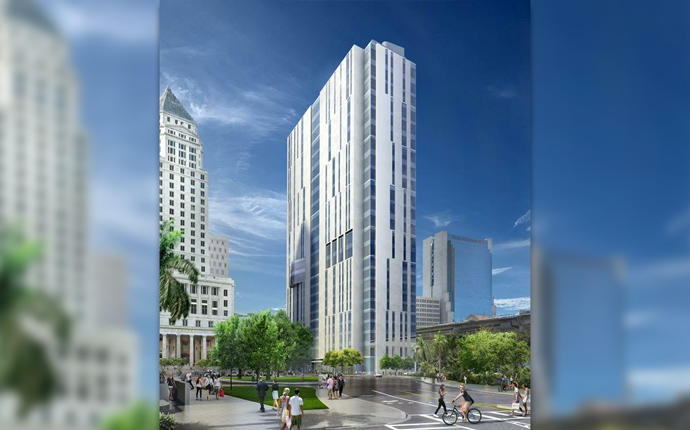Trending
All rise: Miami-Dade commissioners approve $267M downtown Miami courthouse project
Billed as the first public-private partnership of its kind in Miami-Dade, the new courthouse will have 46 courtrooms, space to accommodate future growth and 59 parking spaces

The Miami-Dade County Commission on Tuesday unanimously approved a deal with Plenary Group to build a new $267 million civil courthouse in downtown Miami.
The proposed 23-story building will replace the 1928-era courthouse at 73 West Flagler Street that was the site of a trial of Chicago mobster Al Capone.
Amid a packed audience of local judges and attorneys, county commissioners moved forward with a public-private partnership agreement with Plenary after getting the green light from the Federal Transit Administration. The agency had a say in the development because of a parking lot under a Metrorail track that is part of the project, and is tied to federal transportation funds.
“I think we got a very good product at a very reasonable cost,” said Miami-Dade Mayor Carlos Gimenez. “In the end, I think we got it right.” The mayor’s office negotiated the terms with Plenary, a Melbourne, Australia-based developer specializing in public-private partnerships.
Plenary will build the new courthouse on West Flagler Street and Northwest First Street, west of the existing courthouse and east of the Metrorail. It will use private funds, and operate the facility under a 30-year contract with the county worth an average of $27 million a year.
The courthouse will have 46 courtrooms, space to accommodate future growth and 59 parking spaces.
By 2053, Plenary could collect roughly $850 million under what Miami-Dade leaders said is the first public-private partnership by the county. If Plenary falls short on operational and maintenance standards, such as backup power not working during an electrical outage, the company’s annual payments would be reduced.
Instead of a typical ground lease agreement, this public-private partnership is based on Plenary’s performance operating and managing the new building, which will be owned by Miami-Dade and built on county-owned land, said Plenary Vice President Mike Schutt.
Plenary will design, construct and raise financing for the buildout, but the company won’t start receiving the first of its 30-year annual payments until the new courthouse is open for business, Schutt said.
“Those payments are tied to hundreds of performance requirements,” he said. “If we fail to meet any of those metrics, there would be a deduction from the available payments that we would not receive.”
Schutt said Plenary has 34 active public-private partnership projects in the U.S. and Canada, including the Long Beach Civic Center, which includes a new city hall, library and courthouse in Long Beach, California.
Five years ago, Miami-Dade voters rejected a general obligation bond issue to build a new courthouse, so judges, attorneys and county leaders sought another alternative. Gimenez had preferred building a new courthouse next to the existing Children’s Courthouse as a way to save money on construction costs. But county commissioners preferred a location on Flagler Street that was also favored by Miami-Dade judges.
Despite Gimenez’s warnings that paying for the courthouse without improving Miami-Dade’s financial forecasts would lead to future service cuts, commissioners approved a bidding process that Plenary won. The mayor had projected the new courthouse would cost the county $1.2 billion over 30 years, but Plenary submitted a bid that dropped the price by about 35 percent.
Meanwhile, the county will seek developers interested in converting the existing courthouse, which is a historic landmark, for commercial use, either as a hotel or office building. Whichever entity takes control of the property would have to address deteriorating conditions including leaking exterior walls and mold issues.




